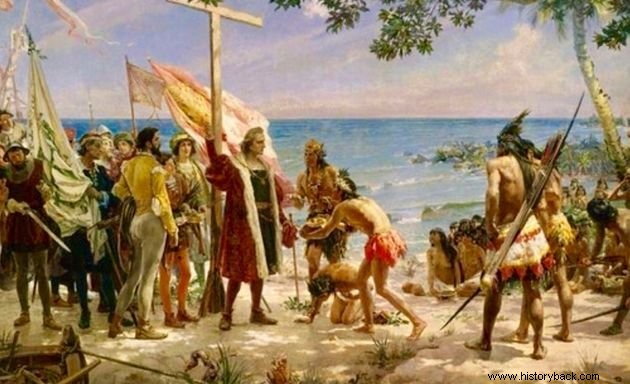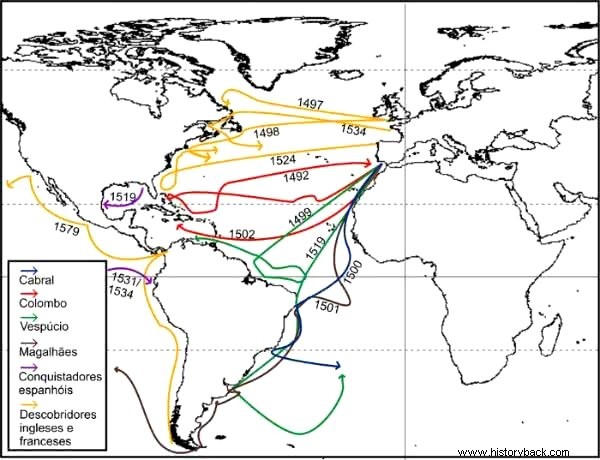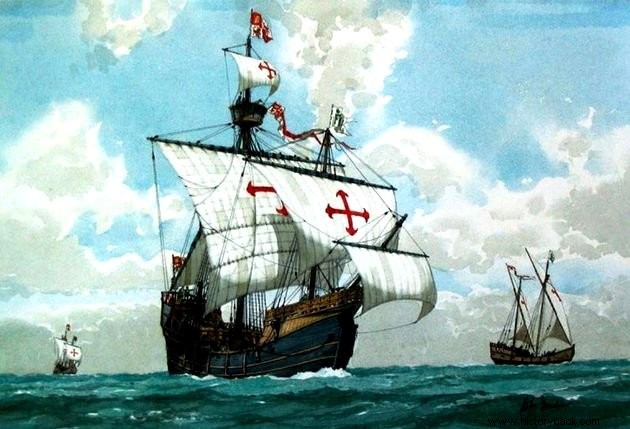It's called Discovering America the arrival and occupation of America by the navigator Christopher Columbus (1452-1516) on October 12, 1492.
The expedition was sponsored by the Catholic Kings of Spain, Ferdinand of Aragon and Isabella of Castile.
Currently, the use of the word "discovery" to name this feat is questioned, as the lands were already inhabited by native peoples.
The Quest for the East
With the difficulties imposed by the Turks to European trade, after the capture of Constantinople in 1453, the search for an alternative route to the Mediterranean became a priority for Europe.
At this time, Portugal was leading a series of maritime expeditions that led it to take possession of the Atlantic islands such as the Azores, Madeira and the city of Ceuta, in Africa.
Then, the Portuguese started to travel through Africa, but without losing sight of the coast of this continent.
As the kings of Castile were also interested in going to sea, both crowns signed several treaties in order to divide up the discovered and undiscovered lands.
One of the agreements signed was the Treaty of Tordesillas, in 1492, which divided the world between Portugal and Spain.
See also:Fall of ConstantinopleColumbus Maritime Expedition

In this context, the Genoese navigator Christopher Columbus nurtured the idea of reaching the Indies by sailing through the west. In other words, he wanted to try a new path hitherto unexplored.
This route was based on a map by the Florentine Paolo Toscanelli (1397-1482), and the idea was presented to the King of Portugal, Dom João II (1455-1495). The monarch denied the support, as he doubted that it was possible to do so.
Columbus leaves for the kingdoms of Castile and Aragon in search of help. Despite being unified, part of the Castilian nobility wanted to continue to sustain wars on the European continent. The other part wanted to take the risk of seeking the so-called "new world".
After seven years of meetings, arguments and intrigues, Columbus gets the money to carry out his venture. Thus, he left on August 13, 1492, with only two caravels:Nina and Pinta and the ship Santa Maria.
The crew consisted of 90 men who arrived in America 61 days later, docking in the Bahamas and, soon after, in Cuba and Santo Domingo.
Columbus believed he had found the Indies and tried four more times to reach Indian markets. He always believed he had reached Asia, however his incursions resulted in the discovery of the Antilles and Central America.
See also:Spanish AmericaA New Continent:America

It was in 1504 that the Florentine navigator in the service of Spain, Amerigo Vespucci (1454-1512), classified the new discovered lands as a continent.
The fact was confirmed in 1513 by the navigator Nuñez de Balboa (1476-1519) who crossed Central America and reached the Pacific Ocean.
Later, the cartographer Martin Waldseemüller (1470-1520) would begin to use the term America in their maps, in honor of Amerigo Vespucci, to designate the "new world".
For his part, in 1519, the Portuguese navigator Fernão de Magalhães (1480-1521) began the first circumnavigation voyage around the planet.
Rejected by the Portuguese king, he placed himself in the service of the Spanish monarch Carlos I (1500-1558). His expedition departed Cádiz, and made stops in the Canary Islands, Recife and Buenos Aires. From there, he crossed the Estreito de Todos os Santos, which was later called "Magalhães" in his honor.
With that, he managed to reach Asia, especially the Philippines and the Moluccas.
Magellan died in 1521, in the Philippines, in combat with the natives. The voyage was completed the following year by Spaniard Juan Sebastián Elcano (1476-1526) and eighteen survivors.
See also:First Peoples of AmericaThe Great Navigations

The great navigations were boosted by the closing of trade routes by the Turks, after the fall of Constantinople in 1453.
The conquest of an unknown world represented a challenge for the national monarchies, who saw in this undertaking a way to legitimize their power and expand their territory.
The European continent received from the East sugar, gold, camphor, porcelain, precious stones, pepper, cloves, cinnamon, nutmeg, ginger, medicinal drugs, balms, ointments, perfumes and aromatic oils.
The goods that left the East for the West were transported by Arabs in caravans carried out by land to Italy, reaching Genoa, Venice and Pisa.
As intermediaries, these cities monopolized trade in the Mediterranean Sea and there was pressure from the national monarchies to break the monopoly.
In addition to the paralyzed commerce, the union between the State and the bourgeoisie consisted of another important factor for the great navigations. It was in the interest of monarchs and burghers to finance technology to subsidize maritime incursions.
Thus, the barinéis, small boats with two masts and square sails, appeared; followed by the three-masted caravels and, finally, the more sophisticated and rudder-equipped ships.
From China came the compass, and from the Arab regions, the astrolabe, which will be fundamental to help and make possible long-distance navigation.
All this nautical knowledge, the centralized State, a bourgeoisie interested in expanding its business, and the Catholic Church wishing to expand the Christian faith, favored the success of European navigations to America and Asia.
See also:The Great NavigationsChronology of Spanish Travels to America
| Navigator | Year | Fact |
|---|---|---|
| Christopher Columbus | 1492-1493 | Arrival in the Bahamas |
| Christopher Columbus | 1493-1496 | Island of Guadeloupe, Puerto Rico and Jamaica |
| Christopher Columbus | 1498-1500 | Costa of Venezuela |
| Alonso de Ojeda | 1499 | Exploration of Venezuela |
| Vicente Yáñez Pinzón | 1500 | North coast of Brazil in February |
| Christopher Columbus | 1502 | Honduras |
| Nuñez de Balboa | 1501 | Discovery of "Terra Firma" |
| Nuñez de Balboa | 1513 | Discovery of the Pacific Ocean |
| Ponce de Leon | 1513 | Arrival in Florida (USA) |
| Juan Díaz de Solís | 1516 | Discovery of Argentina |
| Ferdinand Magellan | 1519 | Globe circumnavigation, discovery of Chile |
| Pedro de Alvarado | 1521 | Conquest of Guatemala and El Salvador |
| Francis of Orellana | 1535 | Discovery of the Amazon |
Also read on this subject:
- European Maritime Expansion
- Portuguese Navigations
- South America
- Spanish Colonization
